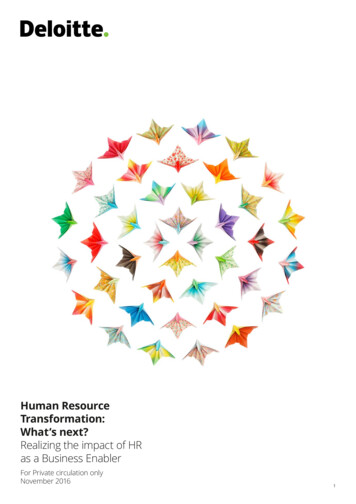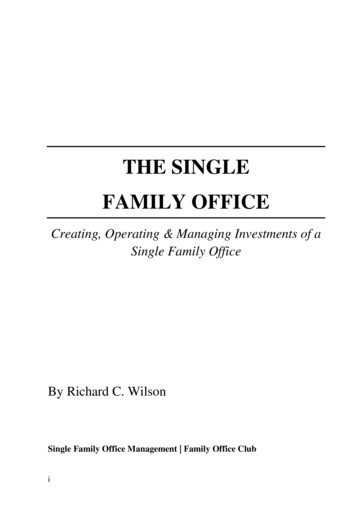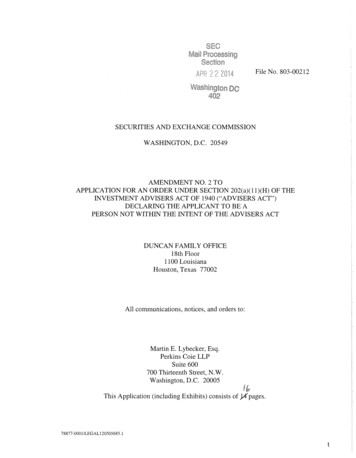
Transcription
The Family Office HandbookAchieving ambition. Managing risk. Leaving a rich legacy
ContentsIntroduction1Family office fundamentals2– Characteristics of a family office2– When is it time?3– Services to be provided4Operational considerations5– Governance5– Cost structure6– Talent7– Technology8Management considerations9– Risk management and controls9– Legal, tax and regulatory10Bringing the family office vision to life11– Investing and managing family wealth11– Philanthropy12– The impact of global reach13Looking ahead14An experienced team16
The Family Office Handbook Achieving ambition. Managing risk. Leaving a rich legacyIntroductionWith the creation of significant wealth, new worlds often open for high net worthindividuals and their families. Exciting opportunities as well as new challenges canarise as the family acclimatises to the increased complexities of wealth. One importantdecision may be establishing a family office* to oversee the financial affairs of the familyrather than relying on financial institutions to provide those services.That is a big step, one that involves many logistical, operational, and even emotional considerations. Yet it is a bold move that many othershave made in recent decades. Wealthy families have been taking more hands-on control over investment policy decisions as a result ofcontinued capital market uncertainty and their desire to commit resources to making an impact in the world now and in the future. Also,in this era of increasing risk, investment fraud, and cybercrime, more families have been adopting an institutional approach to family riskmanagement. This process is aided by the advancement of and growing reliance on technology in family financial affairs.In such an environment, establishing and operating a family office, or expanding the services of an existing family office, requires carefulanalysis and planning to properly manage, protect, and grow a family’s wealth. Deloitte can help at each step along the way so that the legacya family has built sustains its interests in the future.This publication is a starting point. It is designed to help wealthy families build on their current understanding of what a family office is,consider factors that have contributed to the success of other family offices, and formulate a plan that leads to the creation, transformationor expansion of their own family office. While not intended to address every question arising, it should serve as food for thought anddiscussion. We invite readers to join us for that conversation soon.A family office is: An increasingly popular concept albeit the original roots extend back to the 1800s when they were established to manage thesignificant fortunes of successful early entrepreneurs A private organisation established by a family to oversee, directly or indirectly, the financial affairs of the family Often the result, like wealth accumulation in general, of owning a successful family business In certain instances, formed by a principal of a hedge fund or private equity fund who decides to no longer advise on funds withthird-party assets, instead evolving into a standalone family or private office to solely manage his or her family’s wealth An organisation that offers many of the same services as top-tier private banks and investment firms, but devoted to the needsof a single family A highly tailored organisation, often reflecting the characteristics and aspirations of the family it serves*This publication focuses on single family offices: private organisations established by families to oversee, directly and indirectly, their financial affairs. References to a “familyoffice” throughout this publication refer to a single family office unless otherwise stated. In contrast, a multi-family office is an organisation that serves multiple non-relatedfamilies. Sometimes, these are former single family offices that have broadened their client base to serve other non-related wealthy families. More often, multi-family offices arethird-party wealth management firms that provide outsourced services to wealthy families.1
The Family Office Handbook Achieving ambition. Managing risk. Leaving a rich legacyFamily office fundamentalsCharacteristics of a family officeWhile each family office is as unique as the DNA of its individual founders, there are some common goals that most family offices striveto achieve: To provide formal structure for the management and governance of the family’s wealth To promote the family’s legacy, vision, and values To co-ordinate, integrate, and consolidate customised services for the family To manage economic and personal risks for the family To capitalise on economies of scale gained from consolidated family wealth accumulation, such as preferential investment access andlower fee rates To maintain confidentiality and privacy of family affairsTraditional paths of the family officeOne of several scenarios often results in the formation of a family officeScenario 1: SeparationA successful family business has grownsignificantly and profits from thebusiness have been diversified intonew active or passive investments.The management and administrationof those investments has becomehighly demanding for family businesspersonnel. To mitigate conflicts ofinterest and other risks, the family’snon-business operations embeddedwithin the company are separated intoa newly established family office.2Scenario 2: Liquidity eventA successful family business orentrepreneur-owned business ismonetised through, for example, aminority interest sale, majority interestsale, or recapitalisation. A family officeis established following the liquidityevent to provide a formal structureto promote family governance anddecision making around the resultingwealth.Scenario 3: Fund redemptionA hedge fund or private equity fundmanager redeems out third-partyinvestors of the fund. Subsequently,the fund manager evolves into a familyoffice, now serving the principal andfamily members.
The Family Office Handbook Achieving ambition. Managing risk. Leaving a rich legacyFamily office fundamentalsWhen is it time?While opinions vary widely about the amount of wealth necessary to form a family office, a traditional threshold is at least US 250millionof investable assets. In general, it is believed that this amount of wealth is necessary for dedicated resources to provide favourableeconomies of scale from both a time and money perspective.But the amount of wealth involved is not the only important consideration. There are a number of key integrated, qualitative factors thatalso should be considered. As more of the factors become relevant, so does the value proposition for the formation of a family office.This due diligence process is an important step in assessing when and how to initiate the formation of a family office. With the guidanceof trusted advisers, the diligence process provides a structure for weighing these important factors, which will help a family determinewhether and when a family office makes sense.Integrated factors in the decision to form a family officeThe amount of wealth involved is only one of many factors that drive the decision to form a family office.Separation of family financesfrom the family businessalthent of wAmouedinvolvNumber of family linesand generation servedTypes and level of servicesto be providedFamily chemistryand alignmentDesired level of familycontrol over servicesComplexity of family holdingsImportance of family legacyand successionOther family-specific factors3
The Family Office Handbook Achieving ambition. Managing risk. Leaving a rich legacyFamily office fundamentalsServices to be providedWealthy families have numerous options for obtaining personal and financial services. A key success factor in forming a family office is toengage the right people to do the right work. For long-term success, it is therefore important to establish and periodically reassess theoptimal balance between services performed in-house by competent family office employees and those outsourced to qualified serviceproviders.For those activities that the family office chooses to outsource, the family office executive must build the right advisory team and choosethe right third-party providers to deliver those services. Developing a network of resources who are specialists in the respective serviceofferings is key to putting an effective team in place.Scope of family office servicesStrategicservicesTechnologyTax and yLegalFamilyFinanceOperationsFamilyeducationSocial mediaTax ssionMonitoring& oversightof outsidecounselConciergeservicesBookkeeping &reportingTalentGovernanceTechnologyplatform &controlsTax ation agementOffice policies& proceduresSuccessionplanningCloudcomputingWealth transferplanningManagerselectionFraudprevention ewPropertymanagementBudgeting &forecastinganalysisFamily esignBenchmarkingPhysicalsecurityCharitablebench- rmancereportingCyber riskDue plianceMost often done in houseSometimes done in houseMost often outsourced Many in-house services (items shown in dark green) address daily activities at a granular level. Keeping these services in-houseprovides immediate access to and control over the information. It is also likely to be more cost-efficient and expedient thanoutsourcing. Other services (items shown in blue) may be performed by family office staff and at other times by outside providers or a combinationof the two. This can offer the best of both worlds: cost savings on services that involve lower risk or is less complicated, and cuttingedge planning and quality assurance for more complicated services or projects. The most frequently outsourced services (items shown in light green) typically require highly specialised skills or significantinfrastructure. Few family offices have the appropriate structure or resources to provide these services in house from a risk–returnperspective.4
The Family Office Handbook Achieving ambition. Managing risk. Leaving a rich legacyOperational considerationsGovernanceEstablishing and operating a family office, or expanding the services of an existing familyoffice, requires careful consideration and planning to properly manage and protect afamily’s wealth so it can flourish over time. As with any organisation, the relative successor failure of a family office relies on effective governance.Important considerations include:Balanced leadership and delegation. Although family officesoften are established by the family’s senior generation, effectiveAttributes of effective family office governanceFamily offices should create a governance infrastructure thatencompasses all activities from the operational to the strategic.governance hinges on both the experienced leadership of thosesenior family members and selective delegation to others. Visionand strategy should be set by the family, with tactical decisions andexecution left to capable family office personnel and supported byoutside advisers.Effective communicationsThe family office often serves as the centre piece for communicationsto and among family members. The family office often hosts familymeetings and organises retreats, and family office leadership isoften tasked with communicating certain messages to the youngergenerations.Board oversightA leading practice among family offices is to establish a board ofdirectors to provide oversight and direction. Careful considerationof board composition is imperative. In most cases, the board shouldinclude both senior family members and objective outsiders who canoffer contrasting perspectives.Succession and contingency planningAnother leading practice is to safeguard the long-term prospectsof the family and family office through succession and contingencyplanning. For example, developing a plan and educating familymembers on what will happen after the family patriarch or matriarchpasses away is an important factor in reducing confusion and avertingdisagreements and misunderstandings over the direction of the familywealth.Develop a missionstatement for thefamily officeArticulate rights andresponsibilities offamily office owners,management, andboard membersEstablish successionand contingencyplans for the familyofficeConsider a boardof directors withmeaningful outsideinvolvementEngage skilledprofessionals tosupport the familyofficeImplement financialand performancebased reportingsystems to developaccurate, timely,and transparentinformationEmbraceclear, regularcommunicationswith familymembersContinuous operational improvementFaced with continually evolving operational challenges, successfulfamily offices and the families they serve thrive on continuous processimprovement and innovation. Whether it is an existing organisation ornewly formed, and whether executives have been in place for years orare newly appointed.While death and taxes are inevitable, their consequences don’t need to be a surprise. Family offices are in a unique position to preparetheir organisation and the families they serve to plan for the inevitable, such as the death of a principal or key family members.Preparedness exercises can put the family office, the family advisers, and most importantly, the family in a significantly better positionto address the personal and business implications of the death of a principal.5
The Family Office Handbook Achieving ambition. Managing risk. Leaving a rich legacyOperational considerationsCost structureFamily offices can provide significantbenefits to the family, but not withoutan adequate annual operating budget.A general rule of thumb is for the annualoperating costs to be approximately 1%of assets under management. However,the actual range can vary widely, from30 to 200 basis points depending uponthe amount and type of assets undermanagement, the complexity of thefamily office operations, scope of servicesprovided, and even whether externalmanagement fees are included in thecalculation.Once annual costs for the family office have been determined,an equally important decision is how the family office willcharge the family for the services provided. The charges forservices provided should be sufficient to cover the familyoffice’s operating costs and ensure that it can operate as agoing concern. Although no industry standard for such chargesexists, leading industry practices include: Variable fees based on hourly rates Variable fees based on a percentage of assets undermanagement Fixed fees based on an agreed-upon scope of services A flat rate designed as a reimbursement for costs allocated A hybrid or combination of any of the aboveWhatever method is chosen, the charges should be fair andreasonable on a comparative basis, transparent to the familyclient incurring the charge, accounted for accurately, anddocumented contemporaneously.Some family offices undertake a transfer pricing study to determine a comparable market rate for services. Market-rate pricinganalyses can avert potential tax issues, and provide comfort to fiduciaries that services are provided at a fair rate.6
The Family Office Handbook Achieving ambition. Managing risk. Leaving a rich legacyOperational considerationsTalentA cornerstone and significant successfactor of any family office is the talent itemploys. Attracting and retaining effectivetalent enables a family office to create theappropriate culture, maintain high moraleand retention, and adeptly evolve as familyneeds and dynamics change.Not surprisingly, compensation and benefits are by far the familyoffice’s largest annual costs, representing between 50 and 75 percentof the annual budget. This is why the family should invest significanttime in attracting, retaining, and incentivising its workforce. Family office staff size can range from as few as one or twopeople up to more than 100, depending upon the size of thefamily, the type and extent of services provided, and relativefinancial holdings and activity. The most common family office leadership positions includea chief executive officer (CEO), chief financial officer (CFO),and chief investment officer (CIO). Recently, many familyoffices have added a chief technology officer (CTO) due to theexpanded role and integration of technology. As the business demands of the family office have changedover time, so have the expectations of new generations ofemployees. It is important for family members and familyoffice employers to recognise these changes and considerhow they will respond to them to attract and retain talent.Leading practices for family office talent management: Identify near and long-term talent and leadershiprequirements to meet the family office strategy and mission. Inventory talent and identify any high potentials, highperformers, and gaps in capabilities. Decide how to fill gaps by building, buying, or borrowing. Establish a formal process for hiring including due diligenceand background investigations and onboarding. Execute appropriate legal documents, such as employmentagreements, non-disclosures, and privacy commitments. Define clear roles, responsibilities, and lines of reporting. Create long-term succession and development plans. Develop an employee handbook with policies and procedures. Create a work environment that emphasises employee wellbeing and provides flexibility. Encourage employees to establish goals that directly tie tothe family office’s short and long-term objectives, then tierewards directly to those goals. Institute compensation arrangements that include long-termincentives to promote retention of key employees. Set up a formal performance and review process that includesmeaningful feedback.7
The Family Office Handbook Achieving ambition. Managing risk. Leaving a rich legacyOperational considerationsTechnologyWith technology continuing to transformbusinesses and governments aroundthe world, and as the pace of changeaccelerates, family offices are increasinglyadopting and embracing it throughimprovements that impact operationaleffectiveness, communication with clients,and data security.Digital capabilities can help position a family office to capitalise onopportunities, address a variety of risks, increase efficiency, retaintalent, and provide transparency to key stakeholders.Cloud computing, mobile applications, robotic process automation(RPA), and other emerging technologies can significantly enhance theway the family office staff and stakeholders interact with each other,help contain IT costs, and facilitate efficient operations. At the sametime, these technologies present risks and challenges that requirespecific skills and increased cybersecurity vigilance.Future technology investmentsWhile thinking ahead for the next three to five years, familyoffices are placing their biggest technology bets on: IT security and infrastructure ERP/general ledger upgrades Collaboration sites: document management and storagesystems, e-rooms, file transfer Data storage and retrieval optionality Mobile device applicationsFamily office technology needsThe modern family office relies on an integrated technology platformto effectively serve clients.Custody platformTrading niccommunicationssystemAnother important and growing challenge for family offices is dataaggregation—the ability to access, analyse, manipulate, consolidate,and report on data from multiple sources. Many families have movedto a global custodian to shift the burden of aggregation away fromthe family office. In other cases, third-party expertise and dataaggregation solutions may be warranted.Offsite back-upprotocol andcyber securityElectronic documentretention and retrievalTax preparation andbusiness-orientedsoftwareGeneral ledger andaccounting softwareFamily officeThe sophistication and complexity of any technology platform should be weighed against the needs, expectations, and capabilitiesof family members. The resulting decisions should address those factors both for the near term and in the future as the family beingserved grows and expands its global footprint. Engaging appropriate third-party expertise in this process is a leading practice.8
The Family Office Handbook Achieving ambition. Managing risk. Leaving a rich legacyManagement considerationsRisk management and controlsFor family offices and the families theyserve, the global risk environment isconstantly changing. However, several riskareas continue to be top of mind:Risk management as investment vs. expenseFamilies may perform a risk assessment and develop controls tomitigate the risks identified, with the ultimate goal of preserving thefamily’s wealth.Common risks facing family offices Cyber risk Areas of exposure include personal identities,reputations, public and private schedules, business and personaltravel, investment accounts, business dealings, and many more. Fraud risk This is an infrequent, but important area of exposuredue to family office proximity to cash and assets and the significantcontrol a single employee may have over financial activities andfamily communications.FinancialTechnologyEmployment Improper tradeauthorisation Cybersecurity Payroll fraud Data confidentiality/privacy Internal data theft Deviation frominvestment policy Business continuity Organisational and operational risk This includes family officeemployees, processes, systems, and external parties, as well as thephysical security of family members themselves.The family office is in a better position than any individual familymember, adviser, or service provider to monitor and manage suchrisks for the family. A family office’s approach to risk managementdepends on many factors, including the size of the office, theexperience of its personnel, and the office’s state of development.For family offices of all sizes, a sound risk management frameworkwith effective internal controls is essential.Many family offices are beginning to reframe how they think aboutrisk management. The resulting projects are not viewed as necessaryexpenses, but rather as investments in the future of the family’sreputation and well-being, as well as preservation of the family’sassets. Family offices with strong risk management frameworksare often better prepared to withstand market disruptions, cyberattacks, internal fraud, and other relevant threats.Controls and risk reconciliations Dual signatures fortransactions Dual signatures fortransactions Stringent assignment of access Stringent assignmentof accessSegregationof dutiesIT controls Up-to-date segregationpolicies with periodic spotchecks Stringent remove-accesspolicy Comprehensive dataencryption Enforcement of passwordpoliciesConsider this: Internal controls are the processes and procedures that a family office uses to build integrity and security into its criticalfunctions. As with any successful business, the sooner internal controls are introduced, the better equipped the family office will be tomanage risk and discourage inconsistency and unreliability in its management of the family’s affairs.Risks evolve over time, particularly as the family itself and the family office’s personnel and systems change. A leading practice is toconduct a periodic formal risk assessment to confirm that internal controls are effective and appropriately focused. Results should bepresented to the board so the family stays informed and engaged.9
The Family Office Handbook Achieving ambition. Managing risk. Leaving a rich legacyManagement considerationsLegal, tax and regulatoryThe legal, tax and regulatory framework forfamily offices can be complicated, requiringthe expertise of competent advisers. Thefollowing are common focus areas:Legal considerations Should the family office be structured as a company,partnership, trust or something else? Who will own and control the family office? What is the appropriate legal jurisdiction for the family office? What other legal agreements are necessary, such asemployment agreements and service agreements?Tax considerations For tax purposes, how should the family office be structured? Will the family office activities rise to the level of a trade orbusiness? Are there gift or estate tax issues concerning family officeownership and succession? Will there be a tax impact for family members? How will the role of the family office impact international familymembers and/or structures? Is there sufficient flexibility to cater for change in tax andregulatory rules as well as family circumstances?Family offices can effectively prepare for enquiries/audits by tax authorities by conducting a periodic audit readiness assessment. Thiscan range from a simple discussion with internal advisers to a detailed audit readiness assessment that includes document analysis,interviews, and other data gathering.Note: The comments in this section only provide a cursory overview of the legal, tax, and regulatory environment applicable to family offices.Matters concerning the structure of family offices can become complex where multiple jurisdictions are involved and therefore it is importantto seek tax advice before establishing a family office.10
The Family Office Handbook Achieving ambition. Managing risk. Leaving a rich legacyBringing the family office vision to lifeInvesting and managing family wealthHow the family wealth is invested typically defines the family office.Investment services provided by or co-ordinated through familyoffices often include: Developing investment objectives, including drafting of investmentpolicy statements, assessments of risk tolerance, and creation ofappropriate target asset allocations Selecting appropriate investments based on the family’s shortand long-term needs, and periodically rebalancing or makingadjustments to the portfolio Selecting, engaging, and managing relationships with investmentadvisersCommon themes and trends for family office investing: A long-term investment horizon, perhaps spanning generations Unencumbered by regulatory constraints placed on institutionalinvestors Diverse and non-traditional asset allocations Significant interest in private equity direct invest and co-investopportunities Focus on wealth preservation vs. growth. The more generationsserved, the stronger the focus on preservation Reviewing asset holdings and investment performance Liquidity preferences driven by the relative cash needs for thefamily Managing cash and liquidity Use of family pooled investment vehicles to promote co-investment Overseeing investment due diligence A more recent emphasis on social impact investing and venturephilanthropy Providing periodic investment account statements andperformance reporting11
The Family Office Handbook Achieving ambition. Managing risk. Leaving a rich legacyBringing the family office vision to lifePhilanthropyPhilanthropy often unifies a family behind a purpose, encouraging effective governanceand collaboration while giving the family an opportunity to create a meaningful impacton social and environmental issues in their communities and around the world. It alsoengages younger generations in the family vision and succession. Similar to investing,philanthropy is often a cornerstone activity for the family office.However, families today have more options than ever before to createsocial and environmental impact. Today’s philanthropists can donatethrough an array of vehicles, ranging from private foundationsand charitable gift funds to community foundations and onlinegiving platforms. The abundance of charitable vehicles is furthercomplicated by a new set of options that are emerging as ways forindividuals to try to effect change, such as political contributions,socially responsible investing, and impact investments in socialenterprises and social purpose businesses that produce bothfinancial and social returns.The family office can be a key player in helping family membersnavigate among and across these options. The family officeexecutives coordinate with expert philanthropic advisers to assist thefamily in understanding issues and effective practices, establish clearcharitable goals, and align those objectives with the strategies andtactics that can more effectively achieve the family’s philanthropicvision.Family offices can also be a critical aid in helping individuals makesense of the complex tax issues related to charitable giving.For the family who desires to create a legacy and have greater control over its charitable giving, a private foundation may be anappropriate charitable giving vehicle.12
The Family Office Handbook Achieving ambition. Managing risk. Leaving a rich legacyBringing the family office vision to lifeThe impact of global reachAdvancements in technology and better access to information, resources, and marketscontinue to expand global opportunities. Wealthy families are at the forefront of thisshift. Whether through geographic dispersion of family members, property ownershipin foreign jurisdictions, or investments made in foreign companies, wealthy families areincreasing their global footprint. A family office can provide the necessary support toaddress the wide variety of issues that can arise from the increased global reach of thefamily.Global communicationThe ability to connect in person becomes more limited whenfamily members reside in different jurisdictions across the globe.Having a secure communication platform to share informationamong the family, family offic
Contents Introduction 1 Family office fundamentals 2 - Characteristics of a family office 2 - When is it time? 3 - Services to be provided 4 Operational considerations 5 - Governance 5 - Cost structure 6 - Talent 7 - Technology 8 Management considerations 9 - Risk management and controls 9 - Legal, tax and regulatory 10 Bringing the family office vision to life 11










